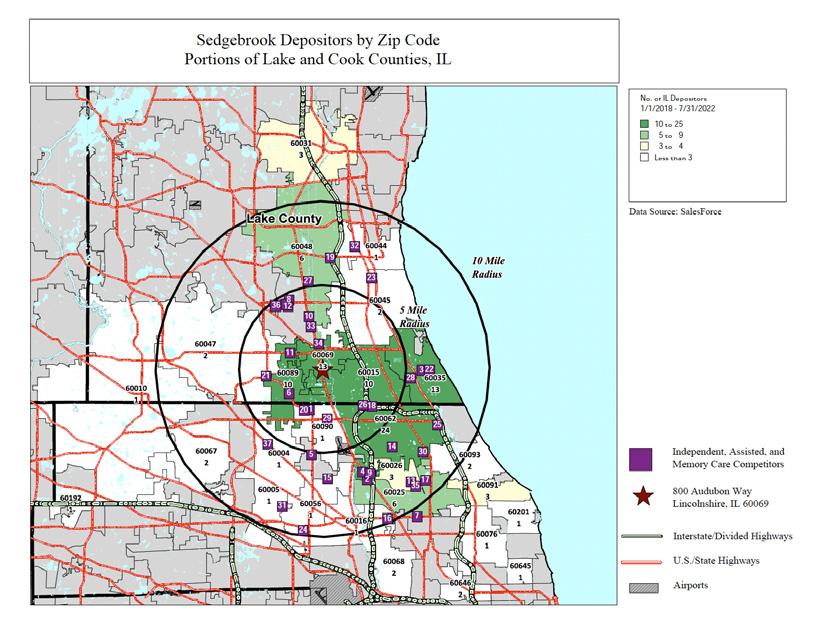

LCS DEVELOPMENT
Marketing Playbook

SECTION I Development Plan
Introduction
The Development Plan marks the start of the development process and is a critical task in the management and execution of a project. A development plan is the basis for developing the budget and the schedule for work where the culmination of master planning efforts is applied and finalized in order to determine the required resources and durations for individual tasks. The plan allows for the team to make sure that the master plan or a particular phase of the master plan is financially feasible, and the market supports the project. Market feasibility is determined through an in-house or external marketing research resource.
A key element of the development plan is the architectural programming. The architectural program is finalized within the establishment of the Development Plan and provides specific, detailed information to guide building design and allow for better cost modeling.

• Market assessment
• Site planning
• Financial review & funding
• Facility assessment
• Construction cost estimates
• Regulatory review
• Define project team
• Select design team
• Conceptual design
• Building analysis
• Market/Competitor research
• Zoning requirements
• Project economics
• Architectural theme
• Marketing plan
• Priority sales
• Identify funding sources
• Site plan approval
• Final schematic design
• Resident programming
• Design development
• Advertising & public relations
• Community outreach
• Sales workshops
• Building permits
• Construction documents
• Financing
• Buyer retention
• Construction oversight
• Monthly project reporting
• Licensure
• Review of space requirements
• Move-in coordination
• Program setup
• Operating policy & procedures
• Staff hire & tracking
Figure: Development Workflow
Occupancy Development Budget
The Occupancy Development Budget is created as a result of the collaboration between the Project Development Manager, Regional Marketing & Sales Director, the Executive Director (if this is an expansion or repositioning project) and the project’s Director of Marketing. Through determining the sales pace and occupancy fill-up, the team can begin to define the overall schedule of the project resulting in a formalized Sales Pace & Fill-up Schedule. In most cases, project sales is put on the critical path and the budgeting for sales helps to define the path. Specific budget line items are created by guiding tenets based on the size of the project and number of homes that need to be sold. A Marketing Tenets & Budget Calculator for Greenfield, Expansion or Repositioning can assist in finalizing the Occupancy Development Budget.
Through thoughtful collaboration you will discuss many of the elements needed to market the project and whether or not they need to be carried in the occupancy development budget based on the scope of the project and if you working on a Greenfield, expansion, or repositioned property. Avoid using a standard cost per sale; you will need to work together to make sure all items required to achieve sales for the project are identified by creating the budget as a team. Sales staff and lead generation will be the two largest items in the occupancy development/marketing budget. A sample occupancy development budget can be used during planning to assure no items are overlooked.
Market Research
Whether working with our in-house LCS Market Research team or an outside firm, the bulk of studying the market is done on the front-end of the project, typically during Master Planning and while finalizing the Development Plan. There are many forms of market research that can be completed based on the scope of the project. Market Assessments are typically the most common, but don’t forget to utilize the other forms of research. Value Analysis and Competitive Shopping reports are a great way to make sure your project is positioned and priced well in the marketplace for a successful sales process. Consulting with our LCS Market Research team to discuss positioning and pricing options is advised. They may recommend holding focus groups to further study the market and arrive at the most effect positioning of the project.


Important to Know
• The Development Plan begins the development process.
• Market feasibility is completed.
• Budgets are created and operational modeling begins.
• A Communication Plan for marketing the project is established and monthly or bi-weekly meetings are recommended
Figure: Market Assessment excerpt
Unit Mix
Utilizing market data, financial modeling, and architectural programming, the unit mix and pricing is created. If the project is an expansion, it is important to consider the profile and pricing of existing homes being sold on campus while determining the unit mix. Price per square foot and careful analyzation of the market research are what drives the assembly of the final unit mix. The final unit mix of residences is a determining factor for decisions to be made throughout the development process, so it is important to be thoughtful and precise in establishing the balance of one bedroom, two bedrooms and even potentially three bedrooms and their prices.
Information/Sales Center
After the Development Agreement has been signed and as a part of the Conceptual Planning (A Phase) part of the project. The Project Development Manager and Design Manager (if assigned) should reach out and discuss the marketing and sales plan with the LCS Regional Marketing and Sales Coordinator, the Executive Director (if the project is an expansion or repositioning) and with support from the projects Marketing/Sales Director. This plan should establish preliminary sales timelines, marketing strategies and the plan for conducting in-person sales presentations and one-on-one prospective resident meetings. Often, existing communities will have office space that can support such a function. But if more FTEs, display areas, digital displays, conference rooms, or offices are required; the development team and community will need to establish a plan and budget to accommodate the additional spaces needed.

Often these spaces will require a renovation or retrofit to accommodate this function. The Project Development Manager, Regional Marketing and Sales Director, Executive Director and Marketing/Sales Director will need to work hand in hand to establish a budget and checklist of what will be needed in the space. This may need to be accounted for as a part of the original development plan and budget. The Project Design Manager can assist in supporting these programmatic layouts, or if a full renovation is required the assigned Project Architect (for a fee if not already contracted) can be contracted to do this work. Space requirements will vary project to project and need to consider if the project will need additional FTEs such as a resident selections coordinator and move-in coordinator. Existing staff can sometimes be utilized to fill these roles by taking on additional responsibility. Whether a model apartment home will be built as part of the Info/Sales Center or whether a digital rendering or virtual reality (VR) approach will be used to inform and sell prospective residents will determine the amount of space needed.
Strategies for Sales Space
In order of cost effectiveness
• Reorganizing space within the existing community to accommodate the increased space needs
• Utilizing an on-site sales office trailer
• Utilizing an on/off site sales condo or villa
• Renting a space or building in close proximity to the community/ project site to retrofit
• Construction of a new building that can be used by the community post project for another function
Early Design
During the Late Schematic Design (B2 for overall concepts) or Design Development (B3 Phase for Unit Resident Selections Packages), the Project Development Manager and Design Manager should reach out and discuss the marketing/sales plan with the LCS Regional Marketing and Sales Director with support from the Executive Director and Community Marketing/Sales Director. The Project Interior Designer will be integrated into these discussions. Consideration should be given to the overall design concept of the community and the style of the design (Traditional, Transitional, Modern, etc.). Regionally, the color and finishes packages for projects will vary as will the requests coming from depositors or residents of the existing community. Often the community sales staff and the interior designer will have a pulse on or weigh in on requests that they have seen previously or if the community has existing design packages, they are already implementing with unit turns in their existing community. The community, in conjunction with the project’s Design Manager and Interior Designer will develop a finish package to meet the community’s expectations. In the later stages, a similar process will take place as a part of the resident selection process for personalizing unit finishes.
The community, in conjunction with the project’s Design Manager and Interior Designer will develop a finish package to meet the community’s expectations.

Communication Plan
Communications in the development process is crucial at every stage. Here is a grid of the audiences and the messages that the PDM and development team need to consider before and during the development process. Missing one of these can have deleterious consequences in the approval, marketing, and sales process. Clear and timely communication with each audience will help the project reach approval, sales, financing, and construction milestones on time and within budget.
Sponsor/Board/Partner
Set frequency of communications and meetings with content expectations. Introduce development team & sales team members. Gain approval of design, cost/budget, and plan of finance.
Regulatory Agencies
Finance groups, approval agencies, city & county officials and elected leaders, market (future residents), development team
Confirm regulatory requirements to construct and operate project - including health care facility if part of the project
Present priority deposit sales plan, budget and milestones. Reporting process for plan and budget monitoring
Present Priority Deposit sales findings and project adjustments. Present Conversion Sales plan and budget with milestones. Reporting schedule.
Current residents of existing community that will be expanded or repositioned
Introduce high level description of development project, sponsor, and developer
Secure approval to market and collect priority deposits. Secure regulatory approval of final residency agreement (contract) and escrow of deposits
Secure approval to begin reserving specific residences with escrowed 10% deposits
Present Priority Sales marketing collateral and process
Present Conversion Sales detailed marketing collateral and sales process
Introduce high level description of development project, sponsor, and developer. Describe anticipated development process, mitigation of construction impact and timing for current residents to reserve a new residence
Introduce advantage of being first to become priority depositors. Introduce development team and sales staff.
Open house introduction of information center/marketing offices and process to reserve residence
Contractor, architect, interior designer, subcontractors and suppliers
Announce major players as hired
Prospective residents
Sponsor/Board/Partner
Introductory letter announcing new project, general info about the project and inviting interested prospects to request further info as it becomes available
Create description sheet for each major participant in the project: sponsor/owner, developer, contractor, architect, interior designer
Invite to become Priority Depositors and the advantages of doing so - along with additional general information about the project and address of the project’s website
Provide descriptions in marketing collateral and in displays within the info/ sales center
Announce opportunity to reserve a specific residence and lock in current price. Advantage is lowest price, best choice and joining the new residents’ community prior to opening.

Regulatory Agencies
Finance groups, approval agencies, city & county officials and elected leaders, market (future residents), development team
Monthly reporting on sales, budget and high-level marketing strategies and depositor profiles. Introduce sponsor/board to depositors.
Introduce Executive Director and operations staff as hired. Present refined operational budget. Participate in groundbreaking ceremony
Video tours of construction progress. Participate in opening ceremonies.
Secure certificate of occupancy to begin occupancy by staff and residents. Secure approval to release entrance deposits from escrow
Mix and mingle events with new depositors
Current resident representative(s) participate in groundbreaking ceremony
Pre-opening preview of expansion
Contractor, architect, interior designer, subcontractors and suppliers
Prospective residents
Introduce major players to depositors during quarterly update meetings held after reaching 50% reserved and continued through end of construction. One major presentation by each major player per quarter is suggested
Provide more detail about the project including renderings, site plans, level plans and floor plans along with opportunity to personalize new residence with selection options chosen before and as construction begins.
Contractor and Executive Director presents to depositors on quarterly basis with videos and photography of construction progress. Participate in groundbreaking
Major players participate in opening ceremonies
Project is financed and under construction. Known construction period for secure planning purposes. Join future residents and become part of the community before opening.
Support from sponsor/developer with home sale, downsizing, moving, and settling in. The advantage of being first resident in a brand-new residence


Important to Know
• The actual location will greatly affect details and timelines impacted by state, county and local regulations.
• The goal of this list is to make sure that the PDM is asking LCS Compliance support staff and/or local counsel, the right questions early enough so as to not have to backtrack or sideline other progress while the regulatory work gets up to speed.
• Any new project will be as assigned to the LCS Compliance Team based on current assignments or workload.
• Any new LCS-D project for a current managed community will continue with that same compliance
Regulatory Considerations
1. Life Plan regulatory environment: State oversight of life plan communities varies greatly, including the approvals and oversight of development projects. LCS’s Compliance Department maintains current research on each states’ CCRC laws and requirements for construction and expansion. Oversight may include development planning, use of resident deposits/funds, financing, and agreements.
a. Depending on the state, approvals or filings may begin:
i. Prior to taking priority deposits
ii. Prior to offering a CCRC contract (residency agreement)
iii. Other points determined by state law
b. PDM should understand how the CCRC regulations impact any necessary:
i. Approval or filing of Priority Reservation Agreements
ii. Approval or filing of Residency Agreements
iii. Set up of specific Escrow Accounts and funds for resident funds, operational reserves or debt service reserves
iv. Approval or filing of a Disclosure Statement
v. After construction completion, some states may also limit how funds are initially released from escrow
2. Health Center Certificate of Needs and/or Architectural Review
a. Prior to beginning construction or expansion, some states require a Certificate of Need (“CON”) process to be completed. Approximately half of the states have a CON process for SNF beds and about 12 or 13 states require a CON for AL and/or MC construction and expansion. CON approvals generally take several months or over a year to obtain and require a skilled local consultant or counsel to consult. Compliance can help identify whether a particular state has a CON requirement.
b. Similarly, some states require its Department of Health or similar agency review architectural plans prior to construction to ensure compliance with the Life Safety Code. Timing of these plan reviews will vary greatly on the state and their current workload.
c. As part of the initial process, initial licensing applications or materials might also be required – then must be revised before opening (e.g., NY, NJ, and TN).
3. Health Center Licensing
a. Several months prior to opening, work should begin assessing the needs for licensing each level of care.
b. Medicare enrollment for new SNFs will require the state’s license to be issued, but work can be underway – typically, a new SNF should expect a 6-month delay from licensing until the Medicare system is allowing it to submit claims and receive payments.
c. Medicaid enrollment will follow a similar path as Medicare, but timing will vary greatly depending on the agency that runs each state’s Medicaid program.
4. Liquor licensing
a. Liquor laws are unique to each state and local government. The local laws should be explored early on with local counsel to determine what will be required. The liquor licensing process may take several months or over a year, depending on the locality. Additionally, for-profit entities with an out-of-state ownership like most LCS investment communities, may find difficulties or unique approaches required to navigate local ownership and/or restrictive requirements for shareholders and investors in the company.

Several months prior to opening, work should begin assessing the needs for licensing each level of care.
5. Local and Specialized regulatory approvals
a. Additional approvals required at the local level or through other agencies will require some thought and attention prior to opening: food and dining venues, pool and spa, therapy or clinic space, elevators, etc.
b. Local approvals for zoning, building and fire inspections, etc. will require the PDM’s attention to avoid stalling a project waiting for inspection.
SECTION II
Priority Deposit Reservations
Introduction
Before starting the development of a marketing plan and sales strategy for your project, the following information sources should be gathered, reviewed, and discussed by the Marketing & Sales Planning Team:
• Market Assessment (sometimes completed by LCS Market Research and sometimes by another third-party company)
• Focus Group Reports (sometimes conducted and written by LCS Market Research and sometimes for another third-party company)
• Description of the project which gives the general size, location, and positioning, as well as the sponsorship of the project
Key to this early work is to identify the unique selling characteristics that will distinguish the project when introduced to the market. These unique selling characteristics may include location, sponsorship, amenities, services, views, type of residences, contract type and pricing.

Pre-Priority Sales Phase
Announcing the Project
In some projects before Priority Deposit Sales begin, the sponsor/developer may wish to introduce the project to the market. This is an early alert that the project is being planned and asking that if the recipient of the notice (usually a letter sent to age and income qualified households in the market area) would like to be kept informed about the project, to please return the enclosed card with a confirmation of their contact information.
At this point in the project the LCS Development PDM, Sponsor Representative, Executive Director, Project Marketing/Sales director and LCS Regional Marketing & Sales Director will make up the team responsible for developing and executing the marketing and sales plan. A local or national ad agency and PR agency may also be brought on board at this time.
An important objective during this phase is to capture names and addresses of all who may be interested in the project as a future resident or may be useful in supporting the project if public hearings or approvals will be needed before advancing the project.
If the project is an expansion, engaging existing leads already in the sponsor’s current lead base and keeping the current residents informed about the project is important.


An important objective during this phase is to capture names and addresses of all who may be interested in the project as a future resident or may be useful in supporting the project if public hearings or approvals will be needed before advancing the project.
Priority Sales Phase
Once the project team has determined the general size, scope and intended unit mix of the new project or expansion, the Priority Deposit Sales Phase is used to:
• Confirm that the planned unit mix, by size, type and price range is acceptable to the target market
• Enable the start of the sales process BEFORE all plans and approvals are finalized
• Identify and engage a group of Priority Depositors who will be ready to reserve a specific residence when final floor plans and pricing are available. The goal is to create a significant number of Priority Depositors. When final pricing and floor plans are ready, those Depositors reserve about 30% of the new residences within a few months after starting Conversion Sales. Priority Depositors will select a specific residence, sign a residency agreement and pay a deposit equal to 10% of the Entrance Fee for their specific residence.
These three purposes are achieved by offering age and income qualified households in the market area the opportunity to receive a priority number that they will use to
A PowerPoint presentation should be created
to provide information and guidance to prospective residents about the project, the benefit of becoming a priority depositor and how to secure their priority number.
select a new residence in the order of their number. To receive their priority number the depositor household will be required to:
• Complete a survey that indicates the type, size, and price range of a residence they would be inclined to reserve

• This survey includes questions regarding the prospective residents’ plans for moving to the new community (timing) and a brief overview of their financial profile to assure that the price range of their preferred residence as indicated on the survey is within their financial capability.
• Place a fully refundable deposit to secure their priority number (usually $1,000)
• The PPT can be used for individual presentations by the sales staff to explain the advantages of becoming a priority depositor
• First choice for best selection of a residence
• Lowest price to be offered
• Opportunity to personalize their new residence during the construction of the new project
• Opportunity to participate in some of the final design decisions and programming for the new project
• Opportunity to become part of a community of new residents before the new project is open (get to know their neighbors)
• The PPT can be used for group presentations for the same purpose
• At the end of the presentation, priority deposit surveys can be completed, agreements signed, and checks or credit cards accepted to secure their priority number.
Sales & Info/Sales Office During Priority Sales Phase
• Usually the marketing and sales staff during this priority phase will consist of three individuals:
• A marketing/sales director who manages the onsite marketing and sales process and staff and also sells
• A sales associate (residency counselor) and
• A marketing assistant
• The Consumer Relations Management (CRM) software program such as Salesforce, computers, copier, postage machine, projector, and sound system for PPT, screen and portable pop-up signage is usually needed along with hospitality equipment for coffee and beverage service, candy, cookies, napkins etc.
• A credit card machine such as “Square” will be needed for use in the office or at the end of an Introductory PPT presentation off-site to collect Priority Deposits.

Collateral at the pre-priority deposit sales phase might include:
• Stationery (with address of temporary or planned location of the pre-opening Information Center).
• Business cards
• Short, introductory brochure describing project in general, sponsor and planned program.
• Draft site plan, layout and perhaps a preliminary rendering.
• Initial press release announcing the project.
Agreements
The contract, or Residency Agreement, is what the new resident is buying since the contract usually does not give the resident ownership of the residence.
LCS Compliance is usually the author of this document. The Residency Agreement should be developed in concert with the PDM the Regional Marketing & Sales Director and the Executive Director or Sponsor Representative. The LCS Compliance representative will provide a draft that follows the regulatory requirements for the State in which the project is being developed. If this project is an expansion or repositioning (renovation) project, it is an excellent opportunity to consider improvements or changes in the sponsor’s existing contract or Residency Agreement including type and format.
Some states have specific requirements for senior housing and types of contracts that can be offered. Knowing these regulatory requirements and time frames for obtaining approvals is essential.

Attached is a link to several sample Life Plan and Rental contracts or Residency Agreements. Of particular importance is the Services and Amenities Section included in the agreement; access to health care if offered in the contract and the change in Monthly Fee if the resident transfers to other levels of care. Equally important are the sections addressing refund of the Entrance Fee (if any), and how and when subsequent increases in Monthly Fees will be handled.
Addressing these aspects adequately in the Residency Agreement can greatly improve the ability to sell new residences. If the 10% deposit is fully refundable with interest from the time of deposit until opening of the project and if the depositor can be accepted for residency at the time their 10% deposit is made, resistance to
placing the deposit will be significantly reduced. These provisions in the Residency Agreement will increase the ability to sell deposits and shorten the time needed to reach the number of deposits necessary to secure financing for the project.

Some states have specific requirements for senior housing and types of contracts that can be offered. Many times these agreements must be reviewed and approved long before they can be offered to the market. Knowing these regulatory requirements and time frames for obtaining approvals is essential.


Agreements
Some agreements can have specific marketing advantages included such as return of the full Entrance Fee during the first four months of occupancy thus giving the new resident a “satisfaction guarantee” before amortization of the Entrance Fee refund begins. The time for refunding the Entrance Fee may be limited to 24 or 36 months after vacating a residence rather than on resale of the residence. Length of notice time for cancellation of the agreement is also an important aspect for both Entrance Fee and Rental agreements.
It is important to select an agreement type with provisions that will be competitive in the market. Comparing the contract type and terms with the competition at the outset of the development project is an exercise well worth the effort. Engaging local marketing and sales staff in reviewing draft versions of the agreement will help with this analysis.
The time for refunding the Entrance Fee may be limited to 24 or 36 months after vacating a residence rather than on resale of the residence.
If the project is an expansion, consideration of alternative types of contracts with more competitive or economically beneficial terms for services, amenities, refunds and access to health care should be pursued before assuming
that the existing agreement(s) will be offered with the expansion or repositioned project. Similarly even though the same agreement type will be offered, this is a good opportunity to review and improve the existing agreement to make the language more “consumer friendly” and understandable.
The types of agreements are many and varied. In a development project the following agreements will be needed to assure appropriate adjustments to Entrance Fees and Monthly Fees are made after sales begin and before opening. Transfer Agreements both pre and post occupancy will be needed. The types of agreements may include:
• Priority Deposit Agreement
• Residency Agreement
• Selections/Options (upgrade) Agreement
• Transfer Agreement prior to occupancy
• Transfer Agreement following occupancy

Transfer Agreements both pre and post occupancy will be needed.
• Parking Agreement (temporary occupancy of existing residence until new or preferred residence is available)
• Modifications Agreement Post Occupancy – states the approved modifications and the terms for returning the residence to its original design at the resident’s cost upon vacating.
Notes
Depending on the State and local jurisdiction, the names of these agreements may vary and the nomenclature used within these agreements may vary. If this is a project that will include assisted living, memory care and/or skilled nursing, there will usually be separate residency agreements for each of these health care settings. The approval process for these agreements and for the projects themselves can require considerably more time than for the independent level agreements. Getting these started in the review and approval process as early as possible will be important to keep the project on schedule.
Pricing of Homes
Careful consideration is taken in creating the pricing at two different times during the development process. Utilizing all the data we have available, whether
The second pricing effort is the most important and takes place just before the sales conversion process.
it be market research in the form of a Valuation Analysis and Competitive Shop, or existing pricing on campus. A price per square foot is created for the base price for each home. Premium pricing is added to the base price of each residence that reflects specific views and locations that increase the value of the residence. Holding pricing at base price will help drive sales of homes with challenged locations or views.
The first pricing effort is created during the priority reservation process, at which time, a price range is assigned to each home type and size. Marketing will use these price ranges when encouraging
potential resident secure a priority number by placing a priority deposit for the planned project or expansion. To become a priority depositor with a priority number requires completing a survey in which the potential resident selects their preferred residence using a proposed price range list that shows a price ranges for each specific type and size of residence planned for the project. Again, the goal at this juncture is to prove the market will support the project and the price ranges as presented at this point in the project.
The second pricing effort is the most important and takes place just before the sales conversion process. At this juncture the priority process has confirmed the marketability of the homes. (A significant number of potential residents have placed priority deposits (usually $1,000 fully refundable priority deposits) and indicated their preferred residence size and price range in a Priority Survey.) The PDM has verified the pricing of the residences supports the amount of interim debt that will be offset by the entrance fees collected in the sales process. Consideration to the return on capital contract types (if

To become a priority depositor with a priority number requires completing a survey.

multiple contracts types are being offered) is essential to making sure the proper amount of entrance fees can be collected. As well as, tracking the sales as they are occur to make sure when stabilized occupancy is reached, the projected debt amount to be discharged with the entrance fees has been collected.
There should also be conversation and documentation of price increases per the financial model of the project to reflect sales price increases at certain milestones or times during the pre-construction, construction and opening of the project. After all the above is considered, final pricing is consolidated into a marketing price sheet that shows the entrance fee range (there will be an entrance fee price range for the same residence
Price increases help to incentivize depositors to secure the lowest possible entrance fee for their desired residence at the earliest opportunity.
model type since the base price combined with the premium pricing factors will vary the entrance fee for the same residence model type based on the amount of premiums added to the entrance fee.) This price sheet is used during the sales conversion phase from Priority Depositor to 10% Depositor. The prices are usually increased when the conversion
sales phase ends and full sales begin. Additional price increases will take place annually at the beginning of the calendar year fiscal year for the project. Additional increases will occur when construction begins and when the project opens. This means that during the sales process from start of conversion sales to opening there may be as many as five price increases. These price increases help to incentivize depositors to secure the lowest possible entrance fee for their desired residence at the earliest opportunity.
Pricing New Residences vs. Existing Residences

If the new project is an expansion or addition to the community, and if the new residences carry similar floor plans in type and/or size, it is important to determine if the new residences should carry the same or higher EF price. Usually if the Residency Agreement is the same for both the existing and new residences, the monthly fees for the existing and new residences will be similar. If the existing residences have outdated finishes, a higher price for the new residences may be justified.
However, if the intent is to bring existing residences up to the same standard as the new residences as turnover occurs, it is important not to price the new residences so high that after updating the entrance fees for the
If the existing residences have outdated finishes, a higher price for the new residences may be justified.
refurbished residence they cannot command the same price as the new residences. There is extreme pressure to charge more for the new residences. However, keeping the long-range pricing objective in mind is very important at the outset. LCS managed communities are very good at maintaining residences. However, if five years after opening of the new expansion, these “new” residences still carry a significant price differential between the older residences, this difference will challenge and complicate the sales at the community. For this reason, plans and budgeting should be made to bring older residences up to the same standard as the newer residences from the outset. This cost will almost always be more than the typical turnover refurbishment cost and ideally should be part of the overall master plan and budget for the community.

Sales Collateral
As a part of the Schematic Design (B Phase) part of the project. The Project Development Manager and Design Manager should reach out and discuss the sales plan with the LCS Regional Sales and Marketing Director, the Project Advertising Consultant (if onboard), and with support from the community Marketing/Sales Director (if required).
As a part of these discussions, sales collateral should be reviewed. In the early stages of the project, the project design is continually evolving. Therefore, spending significant budget on early sales collateral should be held to what is deemed necessary to collect preliminary refundable Priority Deposits and gather project interest.
Often, the more complex the materials, the higher the dollar value is to complete the work.
This collateral will often be limited to building elevations, conceptual site plans, sketches, watercolor renderings, or very high-level 3D renderings. The Project Design Manager should also be in review with what the plan is with the contracted Project Interior Designer (if assigned) to complete material finish board. As every project differs, so will the sales collateral have deemed necessary by the team. Projects with long waiting lists, or significant pre-interest may not need as much collateral as projects where advertising is necessary to collect interest from the regional market to drive sales. Often this collateral is not a part of the preliminary contract.
Discussions should take place with the Project Development Manager to establish a budget and the Project Design Manager to reach out to 3rd party resources as required to gather bids to develop this material. As the project progresses and is of known financial soundness, and design has progressed to a point where there should be minimal large changes (Often Design Development, B3 Phase). More intricate sales material can be developed as required to help drive sales. This material often consists of more complex 3-dimensional renderings, 3 dimensional axonometric/birdhouse unit plans, 3-dimensional digital building walkthroughs, or virtual reality. Often the more complex the sales material, the higher the dollar value is to complete the work.
COMMUNICATION
Announcement of Priority Sales
Press release
Social media (Facebook, Instagram, etc.)
Micro-website
Direct Mail Letter to area age and income qualified households
Email announcement to existing lead base generated from pre-Priority phase announcements and to existing lead base if this is an expansion project
Short Marketing Brochure (printed and PDF for emailing)
Priority deposit agreement
Priority deposit receipt
Other Documents
Priority Deposit Survey (That includes: a list of planned units by type, size and projected prices ranges; checklist for financial qualifications; projected move timing.)
Draft residency agreements
SECTION 2: Resources
2-1 Priority Process Guide and Training Materials
2-2 Development Sales Cycle
2-3 Priority Survey
2-4 Agreements
2-5 Pricing Documents
2-6 Sales Collateral
2-7 Sales Staff Position Descriptions
SECTION III Conversion Sales

Introduction
Once a successful Priority Depositor process has been completed and floor plans and pricing are finalized. Priority Depositors are called in order of their Priority Number to reserve a specific residence with a deposit equal to 10% of the entrance fee for their specific residence. While this Conversion Sales Phase is going on, any new depositors will still be given a priority number, complete their Survey and make their $1,000 deposit.
Conversion Sales Phase
Converting Priority Deposits to 10% Deposits
When the last Priority Depositor makes their 10% deposit, the Priority Deposit Sales Phase is ended. After that any new prospect will go directly to making a 10% deposit on their specific preferred residence. Usually, entrance fee prices are increased on the remaining unreserved residences when the Priority Deposit Conversion Phase ends.
During this Conversion Sales Phase the following collateral will be required:
• Finalized residency agreement (approved by State if required)
• Confidential data application forms
• Memory health assessment (wellness) forms (as required by State, sponsor, manager)
• Disclosure statement (approved by State if required)
• Escrow agreement (approved by State if required) for assuring safety of 10% deposit
• Marketing floor plans
• Price sheets by residence types for sales and marketing (A spread sheet with base pricing for each individual residence and rationale for each individual residence price premiums for use by the PDM and sales team. Premiums can be based on location, view, floor, distance to amenities and parking.)
• Site plan
• Level plan for each floor showing every residence in each building

Usually, entrance fee prices are increased on the remaining unreserved residences when the Priority Deposit Conversion Phase ends.
• Common area plans
• All these plans should be printed for use with prospective residents and also framed for use in the Information Center and prepared digitally for use in the sales process and on the website
• Scale model or digital renderings and model
• DocuSign will be essential during this phase to quickly transmit and receive agreements with required signatures.
Agreements
See Section 2: Priority Sales, Agreements
Sales Staff and Information Center
Usually, the marketing director and residency counselor are engaged with the Priority Depositors converting them to 10% depositors during this phase. An additional residency counselor may be added at this point to engage with new prospects who wish to join the Priority Depositors and then convert later as their number is reached.
The goal is to have reserved at least 30% of the planned residences with 10% deposits by the end of this phase.
The operation of the Information Center will require cleaning services, hospitality costs for beverages and snacks, postage for the postage machine, copier, cell phone and land line services. For existing communities some of these costs are already captured such as cleaning services.
The Conversion Sales Phase from Priority Depositor to 10% Depositor will usually be completed within 3 to 6 months depending on the number of Priority Depositors and sales staff to complete these conversions. The goal is to have reserved at least 30% of the planned residences with 10% deposits by the end of this phase.

Full Sales Phase
After converting Priority Depositors to 10% Depositors, any new prospect who was not yet become a Priority Depositor can move directly to reserving a specific residence with a 10% deposit.
There is usually a price increase at the beginning of the Full Sales Phase. New price sheets will be needed. Additional renderings and digital information as well as a more complete set of marketing brochures are usually produced during this phase.
The website will continue to grow and carry more specific information about the project.
Buyer retention becomes even more important since this phase usually will last 12 to 18 months and depositors will need to be kept engaged and excited about the new project. Regular quarterly updates, floor parties for future residents who will be living on the same floor, outings and introduction of development team members can be utilized to focus these buyer retention gatherings.
This Full Sales Phase focuses primarily on achieving the required number of reserved residences to secure financing for the project. This requires multiple activities to generate new leads and secure referrals from existing depositors.
Important to Know
The full sales process cannot proceed without a finalized Residency Agreement and State approval, where required.
SECTION 3: Resources
3-1 Task List for Conversion Start
3-2 Communication Documents
3-3 Sales Collateral
SECTION IV
Resident Selections
Introduction
The Resident Selections process is about building relationships with Depositors and ensuring their journey, from deposit to moving into an LCS managed community, is seamless. The Project Development Manager (PDM) is tasked to support this process in collaboration with a Selections and Move-in Coordinator, who serves as a liaison for the Depositors and the Marketing Staff, as well as the Construction and Development Team. It is both this team’s goal and responsibility to retain Depositors and adhere to construction timelines.
The key to the PDM’s and Selections and Move-in Coordinator’s success is organization and attention to detail. The Selections Process has been refined over time to what is currently in place. It is important to follow these guidelines as they set the standard for new development and expansion projects.

This selection process usually takes place once financing of the project is secured and construction begins.
This selection process usually takes place once financing of the project is secured and construction begins. The depositors will be asked to choose their finish packages and pay for any selections outside of the standard selection packages offered. This process typically must be concluded within several months of the start of construction.

Software
While smaller projects may not require the utilizations of a software program to manage the Selections process; many projects will benefit from the use of a software program. Resident Selections software provides one easily accessible place of record for resident selections so the marketing staff, architect, development team and construction team (general contractors and subcontractors) can manage workload easily, meet deadlines efficiently and order materials accurately.
Standard Finishes
As a part of the resident selections process, standard finishes include those finishes which can be included at no cost to the resident. Typically, options will be provided as a part of the planned project that depositors can pick and choose allowing them to personalize their residence and make it their own. Typical standard finish selection options include countertops, carpets, tiles, paint and trim, lighting, hardware, appliance colors, and other flooring surfaces. Typical standard finish
Upgrade/Optional Finishes
As a part of the resident selections process, upgrade finishes include those finishes which can be included at an additional cost to the resident. These finishes are outside the standard cost it would typically take an owner to furnish the unit but can add value in aesthetics and livability.
Examples of upgrade/optional finishes include higher grade appliances, upgraded flooring and hard surfaces, higher quality countertops, more intricate tile, changes in bathroom fixtures and accessories, additional grab bars and upgraded hardware packages, additional ceiling fans, and fireplaces. Specific projects may also allow custom electrical additions and floor plan modifications.
The PDM and DM will need to determine what upgrade options will be offered.
The Project Development Manager and Design Manager will need to determine what upgrade options will be offered during selections process and which upgrade installations will be permitted but will need to be made after construction is complete and the new resident takes occupancy.



SECTION V Construction and Opening Phase
Introduction
During construction, Marketing and Sales usually has a goal of reserving 90% or more of the new residences by the time the project is ready for occupancy. When financing is secured, groundbreaking occurs and selections for residence personalization (selections) begin, depositors who have reserved their future home may begin to have second thoughts as they see the project becoming a reality and are asked to pay for nonrefundable non-standard (upgrade) personalization (selection) items. Keeping cancellations to a minimum during construction is just as important as securing additional deposit sales.
During construction, Marketing and Sales usually has a goal of reserving 90% or more of the new residences by the time the project is ready for occupancy.



An important report for the PDM and sales team during this time is a spread sheet of the depositors indicating their status or likelihood to close and move into the new project at opening. This can be done with a ranking system to identify those depositors who may need attention to keep them committed. One way to do this is to track each depositor’s attendance at quarterly update meetings and other informational and social events held for depositors. Lack of attendance is an early warning that a depositor may not be fully committed and require some personal attention by the sales team. Another indication is if a depositor does not engage with the selections and move-in coordinator during their personalization (selections) opportunity and does not make decisions about the finishes to be installed in their new residence.
To maintain depositor’s engagement and to start depositors toward selling their house (if needed), rightsizing, and planning their move, the PDM and the newly hired Executive Director (if the project is a Greenfield project) will issue three important “official” communication letters. Six-month notice letters inform each depositor of the completion schedule of the project and a window of time (usually over three months) during which they will be able to schedule their move-in. A three-month letter notifies the depositors with more precision about the time frame that they will be expected to schedule their move-in Introduction continued...

An important report for the PDM and sales team during this time is a spread sheet of the depositors indicating their status or likelihood to close and move into the new project at opening.
The PDM and the newly hired Executive Director (if the project is a Greenfield project) will issue three important “official” communication letters: A six-month notice letter; a three-month notice letter; and a one-month notice letter.



and closing. A one-month letter confirms with each depositor their move-in and closing dates. During construction depositors should be invited to presentations on the selections process, downsizing, selling their house and moving preparation steps. Tracking participation of depositors during these presentations will alert the sales staff to those depositors who may not complete their move. It is better to encourage cancellations early in this process so that the residence can be resold rather than waiting until occupancy begins.
Referrals are extremely effective and important for sales.
presentations during construction on the progress of the project with photos, video, and other information for the depositors.
Since referrals are extremely effective and important for sales and there is usually a large depositor group, keeping depositors informed, supported and enthusiastic about their new homes will garner additional sales during this phase. The PDM and other participants such as the contractor or architect should make periodic
See the attached Manual for the Selections and Move-in Process. Reviewing this manual with the PDM, Regional Marketing and Sales Director, Sales Director, Executive Director and Selections & Move-in Coordinator at about nine months before opening is recommended. An example is the Executive Director will need to mobilize department directors to assure that new residences are “occupancy” clean (usually at a more detailed cleaning level than “construction” clean.) Planning the start date for move-ins should include time between residences being turned over by the contractor and the time needed to “occupancy punch and clean” each new residence.
SECTION 5: Resources
5-1 Deposit letters
5-2 Marketing and sales list
LCS DEVELOPMENT Marketing Playbook
Questions?
Contact Xxxxxxxx Xxxxxxxxx
Title of Deparment, LCS Development
Email | Phone number

